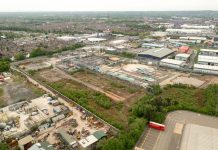
The UK has a little over one year’s worth of industrial space left as the growth in ecommerce and renewed demand for British goods place increasing pressure on the country’s industrial stock, according to new data from global real estate advisors Colliers International.
“Following the outcome of the European referendum, there has been stronger demand for industrial space from the manufacturing sector because of the weakening value of sterling encouraging a surge in demand for British goods. The sector now accounts for 27 per cent of the market, up from 19 per cent in 2016, second only to retailers and wholesalers which account for 33 per cent of demand,” explained Bo Glowacz, senior research analyst, research and forecasting at Colliers International.
Colliers’ data covers the period between 2009 and 2017 to draw a stark contrast between the UK industrial market shortly after the financial crisis when availability of stock was at its highest, with occupiers not taking space and much vacant property and the present-day market scenario.
The state of play
- In the North West of England, existing availability has declined by 57 per cent since 2009, leaving a total of 24 million sq ft available. In the 100,000 sq ft-plus band of industrial property, the decline is even larger at 70 per cent, leaving just six million sq ft available including a handful of Grade A schemes. There is about 1.5 million sq ft under construction in the region with some 1.14 million sq ft of that total being developed speculatively across c.12 schemes. The average size of the schemes being constructed is c.114,000 sq ft, considerably lower than the UK average of 263,000 sq ft.
- UK industrial availability has fallen on average 62 per cent since 2009; with London (down 63 per cent), Yorkshire and Humber (down 70 per cent) and the West Midlands (down 72 per cent) amongst the worst affected. Industrial supply is likely to fall further due to continued demand from e-tailers, lower levels of speculative starts, and the loss of industrial commercial land for other uses such as residential.
- Overall, H1 2017 industrial take-up over 100,000 sq ft has slowed 15 per cent year-on-year to 13 million sq ft from record levels in 2016, amid the slowdown in consumer spending and the uncertainty generated by the recent snap general election. However, H1 take up remains in line with both the five and the 10-year averages.
Prospects for the sector
- The supply of industrial space has also been adversely affected, reducing from 3.6 years in 2009 to just 1.3 years in 2017 in the UK. The worst affected regions are the West Midlands (down to 1.1 years from 3.9 years in 2009) and London (down to 8 months from 2.2 years in 2009).
- Despite the reduction in availability and supply, just 17 million sq ft of industrial space is under construction. Speculative schemes account for just 28 per cent of all UK developments under construction and completions are expected to fall by 60 per cent in 2017, to 3.5 million sq ft.
- The industrial sector continues to attract strong investor interest as H1 2017 investment volumes £3.4 billion, exceeding H1 2016 by 13 per cent.
“There are vast opportunities within the sector as it continues to perform well for investors with rising rental values and potential for further growth. The lack of supply can only present opportunities for developers as there’s clearly occupational demand,” concluded Len Rosso, Head of Industrial & Logistics at Colliers International.
John Sullivan, director, industrial and logistics at the North West offices of Colliers in Manchester and Liverpool, said: “Given the limited supply of new build space in the North West, there is strong demand for good quality second hand space. These supply constraints mean that rental growth is set to continue albeit at a slowing rate because of the economic uncertainty with design and build becoming the only available option for many occupiers.”




















